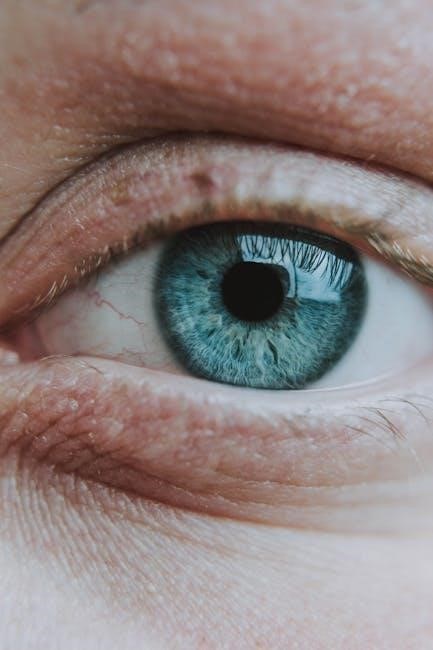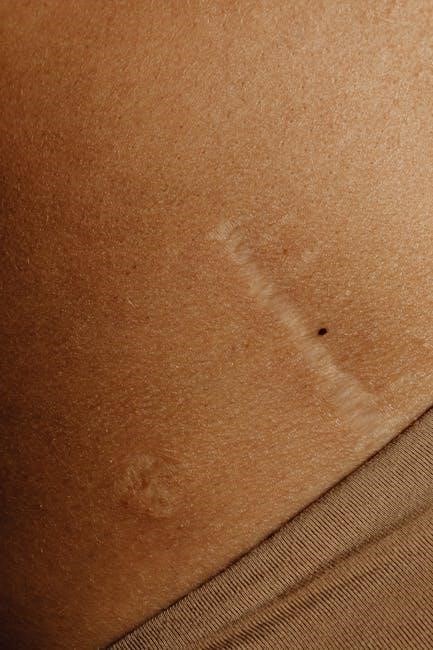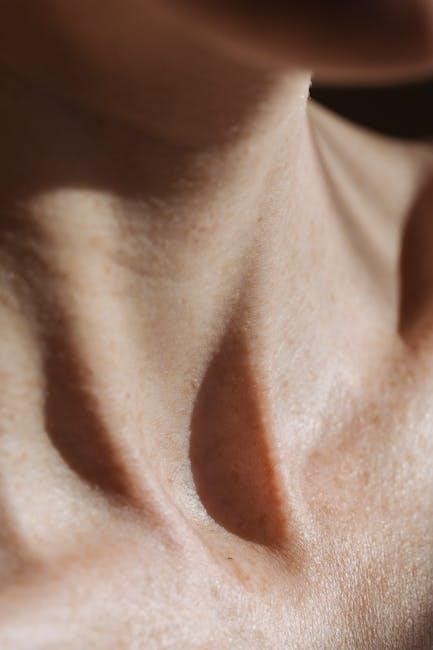This lab manual provides a comprehensive, hands-on approach to understanding human anatomy and physiology, offering interactive exercises, experiments, and multimedia resources to enhance student learning and engagement.
1.1 Overview of the Lab Manual
The laboratory manual provides a structured approach to exploring human anatomy and physiology through hands-on activities, experiments, and multimedia resources. Designed for a two-semester course, it covers all body systems, offering lecture notes, labs, videos, and online interactive tools like BIOPAC exercises to enhance learning and retention. It aligns with various textbooks, ensuring flexibility for instructors and students alike.
1.2 Importance of Hands-On Learning in Anatomy & Physiology
Hands-on learning is essential for mastering anatomy and physiology, as it allows students to visualize and interact with anatomical structures and physiological processes. Through practical exercises and experiments, students develop critical skills, enhance understanding, and retain knowledge more effectively. This approach also fosters active engagement, preparing learners for real-world applications in healthcare and scientific fields.

Key Features of the Laboratory Manual
The manual offers a structured approach, engaging activities, and integration of artwork and multimedia, ensuring comprehensive learning through interactive and visually enhanced anatomical and physiological studies.
2.1 Structured Approach to Learning
The manual follows a systematic workflow, guiding students through each topic with clear objectives and step-by-step instructions. This organized method ensures students build knowledge progressively, from basic concepts to complex physiological processes, making learning efficient and effective for both classroom and laboratory settings.
2.2 Engaging Activities and Experiments
The manual includes interactive activities like term grouping, matching exercises, and written tasks to enhance vocabulary and concept retention. Practical experiments, such as anatomical structure identification and physiological measurements, allow students to apply theoretical knowledge in real-world scenarios, fostering a deeper understanding of human anatomy and physiology through hands-on experience;
2.3 Integration of Artwork and Multimedia Resources
The manual incorporates detailed artwork from renowned textbooks, such as Marieb/Hoehn, alongside multimedia tools like lab videos and BIOPAC exercises. These visual and interactive resources provide students with a comprehensive understanding of anatomical structures and physiological processes, enhancing their learning experience through engaging and accessible content.

Lab Exercises and Applied Activities
The lab manual offers hands-on exercises, including dissection, physiological experiments, and microscopy, enabling students to explore body systems and processes through practical, interactive learning experiences.
3.1 Dissection and Anatomy Identification
Dissection exercises in the lab manual provide hands-on experience with human anatomy, allowing students to identify and explore structures across various body systems. Step-by-step guides and detailed illustrations help students navigate complex dissections, reinforcing their understanding of anatomical relationships and functional significance. This practical approach strengthens spatial awareness and enhances retention of anatomical knowledge effectively.
3.2 Physiological Experiments and Measurements
Physiological experiments in the lab manual offer hands-on experience with measuring body functions, such as heart rate, blood pressure, and nerve responses. Students engage in activities that explore cellular respiration, muscle physiology, and reflex testing. These experiments, supported by tools like BIOPAC, enable data collection and analysis, helping students understand complex physiological processes and their role in maintaining homeostasis.
3.4 Microscopy and Histology Studies
Microscopy and histology studies are integral to the lab manual, allowing students to explore cellular and tissue structures. Activities include examining prepared slides, identifying microscopic features, and correlating histological images with anatomical functions. These exercises enhance visual learning, enabling students to connect structural details with physiological processes, fostering a deeper understanding of human anatomy and physiology through practical observation and analysis.

Pre-Lab and Post-Lab Resources
Comprehensive study guides and assessment tools prepare students for lab activities and reinforce learning post-lab, ensuring effective knowledge retention and skill development through structured review exercises.
4.1 Study Guides and Preparation Materials
The lab manual offers detailed study guides and preparation materials, including lecture notes and interactive activities, to help students understand key anatomical and physiological concepts. These resources, available in both print and online formats, provide engaging exercises and games to enhance pre-lab preparation and ensure a strong foundation for hands-on learning experiences in the laboratory setting.
4.2 Assessment Tools and Review Exercises
The lab manual includes comprehensive assessment tools, such as pre-lab and post-lab quizzes, to evaluate student understanding. Review exercises, like labeling diagrams and case studies, reinforce key concepts. These resources help students identify knowledge gaps and prepare for exams, ensuring a thorough grasp of anatomy and physiology principles and their practical applications in real-world scenarios.

Multimedia and Digital Learning Tools
The lab manual integrates online platforms, interactive models, and lab videos to create a dynamic learning experience, enhancing student engagement with anatomy and physiology concepts.
5.1 Online Platforms and Interactive Models
The lab manual incorporates online platforms and interactive models to enhance learning, featuring 3D anatomical simulations and virtual dissections. These tools allow students to explore complex structures in detail, fostering deeper understanding and engagement with anatomy and physiology concepts. The digital resources are accessible online, making them convenient for both in-class and remote learning environments.
Interactive models also enable students to conduct virtual experiments and analyze physiological data, such as heart rate and muscle activity, providing real-time feedback. This integrates seamlessly with BIOPAC exercises, offering a comprehensive digital learning experience that supports both instructors and students in achieving educational goals effectively.
5.2 Lab Videos and Tutorial Resources
The lab manual includes lab videos and tutorial resources to guide students through complex procedures and concepts. These videos provide detailed step-by-step instructions, allowing students to visualize anatomical structures and physiological processes. Many videos are accompanied by real-time data analysis and observations, helping students prepare for lab sessions and reinforce their understanding of key topics.
- Accessible online for convenience.
- Enhances hands-on learning experiences.
- Supports both in-class and remote learning environments.
5.3 BIOPAC Exercises and Data Analysis
The lab manual incorporates BIOPAC exercises, such as L01, L02, and BSL PRO A04, enabling students to collect and analyze physiological data. These exercises use real-time data acquisition to study heart rate, muscle activity, and other responses. Integration with data analysis software helps students interpret results, reinforcing their understanding of human physiological functions and preparing them for advanced studies in healthcare fields.

Compatibility with A&P Textbooks

Compatibility with A&P Textbooks
The lab manual is designed to complement various A&P textbooks, using artwork from Marieb/Hoehn but adaptable to any A&P text, ensuring versatility for different courses and instructors.
6.1 Versatility Across Different Textbooks
The lab manual’s versatility shines through its compatibility with various A&P textbooks. Utilizing artwork from Marieb/Hoehn, it seamlessly integrates with any A&P text, ensuring consistent terminology and visual elements. This adaptability makes it an invaluable resource for instructors and students alike, providing a cohesive learning experience regardless of the primary textbook in use.
6.2 Customization Options for Instructors
The lab manual offers instructors flexibility to tailor content to their teaching style. With adjustable schedules, customizable exercises, and supplementary resources like answer keys, instructors can adapt the material to meet specific course needs, ensuring a personalized learning experience that aligns with their curriculum goals and teaching methods.

Instructor Resources and Support
The manual provides instructors with comprehensive support tools, including detailed answer keys, time management guides, and customizable schedules, ensuring efficient lesson planning and delivery.
7.1 Instructor’s Guide and Answer Keys
The instructor’s guide provides detailed answer keys for pre-lab and assessment questions, along with estimated time schedules, helping instructors manage their time effectively and ensure comprehensive coverage of all materials without overlap.
7.2 Time Management and Scheduling Tools
The lab manual includes time management and scheduling tools to help instructors organize lab sessions efficiently. It complements online homework systems like Mastering A&P, aiding in tracking student progress and optimizing class time. Instructors can access detailed schedules and resource allocations, ensuring smooth delivery of pre-lab preparation and post-lab assessments, optimizing overall time management, thereby enhancing teaching effectiveness.

Student Engagement and Learning Outcomes
The lab manual fosters active participation through interactive activities, experiments, and multimedia tools, enhancing students’ engagement and promoting deeper understanding and retention of anatomy and physiology concepts effectively.
8.1 Active Learning Strategies
The lab manual employs interactive activities, such as grouping key terms, matching exercises, and written tasks, to foster engagement and critical thinking. Hands-on experiments and multimedia tools encourage participation, helping students grasp complex anatomical and physiological concepts through practical application and visualization.
8.2 Skill Development and Knowledge Retention
The lab manual enhances skill development through hands-on activities, such as dissections, physiological experiments, and microscopy studies. These exercises improve dexterity, observation, and analytical skills. Interactive tools and applied tasks reinforce knowledge retention by connecting theoretical concepts to practical applications, ensuring students grasp and maintain complex anatomical and physiological information effectively.
The human anatomy & physiology laboratory manual effectively enhances learning outcomes by providing practical, engaging, and comprehensive resources, making it an indispensable tool for anatomy & physiology education.
9.1 Summary of Benefits
The human anatomy & physiology lab manual offers hands-on learning experiences through interactive exercises and multimedia resources, enhancing understanding and retention. It provides comprehensive coverage of anatomical structures and physiological processes, engaging students with diverse learning methods. Its adaptability to various textbooks and courses makes it an essential tool for effective anatomy & physiology education.
9.2 Effectiveness in Anatomy & Physiology Education
The human anatomy & physiology lab manual is highly effective in enhancing student understanding and retention of complex concepts. By combining hands-on exercises with multimedia resources, it promotes active learning and practical skill development. This approach ensures students gain a deeper appreciation of anatomical structures and physiological processes, preparing them for successful careers in healthcare and related fields.
